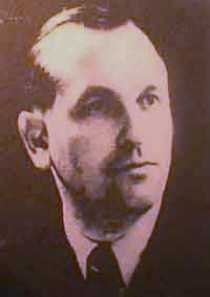Georg Betz
| Georg Betz | |
|---|---|
 | |
| Born |
15 June 1903 Kolbermoor, Bavaria, Germany |
| Died |
2 May 1945 (aged 41) Berlin, Germany |
| Allegiance |
|
| Service/branch |
|
| Years of service | 1932–1945 |
| Rank |
|
| Unit | Die Fliegerstaffel des Führers |
| Battles/wars | Battle of Berlin |
Georg Betz (15 June 1903 – 2 May 1945) was a SS officer (SS number: 625,419), who rose to the rank of SS-Obersturmbannfuhrer during World War II. Betz served as Adolf Hitler's personal co-pilot and Hans Baur's substitute. Betz was present in the Führerbunker in Berlin in late April 1945. On 1 May 1945, Betz took part in the break-out from the Reich Chancellery in Berlin. Early on 2 May 1945, Betz was wounded and died while crossing the Weidendammer Bridge which was under heavy fire from Soviet troops.[1]
Biography
Betz was born in Kolbermoor near Rosenheim (Bavaria). He attended college for mechanical engineering in Munich. Betz then trained as a pilot. In 1932, he became a captain and flew European routes for Lufthansa. He joined the SS and was transferred to the staff of Reichsführer-SS Heinrich Himmler. Betz was appointed captain of the reserve aircraft of Die Fliegerstaffel des Führers. Betz served as Hitler's personal co-pilot and Hans Baur's substitute. Betz was promoted to SS-Obersturmbannfuhrer on 30 January 1944.[1] He further held the rank of Oberstleutnant der Reserve in the Luftwaffe.
Berlin
Betz was in Berlin during the month of April 1945. Betz had been placed in charge of a small fleet of aircraft at the Tempelhof Airport; making sure the planes were flight ready. Further, he was tasked with making a list of staff personnel to be flown out of Berlin to Obersalzberg, after Hitler gave the word to do so. Hitler on 20 April ordered Albert Bormann, Admiral Karl-Jesco von Puttkamer, Dr. Theodor Morell, Dr. Hugo Blaschke, secretaries Johanna Wolf, Christa Schroeder, and several others to leave Berlin by aircraft for the Obersalzberg. The group flew out of Berlin on different flights by aircraft of the Die Fliegerstaffel des Führers over the following three days.[2] Thereafter, Betz was in charge of overseeing the construction of an emergency air strip near the Brandenburg Gate for use by the Führerbunker personnel. [3]
On 29 April 1945, the Soviet Red Army launched an all-out attack on the centre of Berlin. The Soviet artillery opened up with intense fire in and around the Reich Chancellery area. That evening in the bunker complex below the Chancellery garden, Betz was present with Baur when Hitler said his farewell to his personal pilots. Baur pleaded with Hitler to leave Berlin and recited his plan for flying Hitler to safety. It was all in vain as Hitler turned Baur down, stating he had to stay in Berlin.[4] By the following day, 30 April, the Red Army was less than 500 metres from the Führerbunker. That afternoon, Betz was still present in the bunker complex during the time when Hitler committed suicide.[5]
In one of Hitler's last orders, he had given permission for the Berlin forces to attempt a breakout of the Soviet encirclement after his death.[6] General Helmuth Weidling, commander of the Berlin Defence Area, and SS-Brigadeführer Wilhelm Mohnke, the (Kommandant) Battle Commander for the centre government district, devised a plan to escape out from Berlin to the Allies on the western side of the Elbe or to the German Army to the North. Mohnke split up the Reich Chancellery and Führerbunker soldiers and personnel into ten main groups.[7] Betz left the Reich Chancellery as part of one of the groups attempting to break out. After midnight on 2 May 1945, Betz was part of a large group of German soldiers and civilians who crossed the Weidendammer Bridge while under heavy fire from Soviet tanks and guns. Betz was wounded during the crossing. According to Erich Kempka, he came across Betz and left him in the care of Kaethe Hausermann.[8] Other sources give more details as to Betz's fate, stating that he died from his wounds received in the area of the Weidendammer bridge. Betz was age 42.[1]
After the war, a dictated order dated 20 April 1945 by Gestapo chief Heinrich Müller was discovered setting out a flight plan for Hitler's transportation to Barcelona, Spain. Hitler was to have been flown there by Betz in a Ju 290 long-range aircraft.[9] However, due to the insistence of Hitler to remain in Berlin, these plans came to nothing.[4]
See also
- Battle of Berlin
- Glossary of Nazi Germany
- List of Nazi Party leaders and officials
- List of SS personnel
Notes
- ↑ 1.0 1.1 1.2 Joachimsthaler 1999, pp. 286, 287.
- ↑ Joachimsthaler 1999, p. 98.
- ↑ O'Donnell 1978, p. 97.
- ↑ 4.0 4.1 O'Donnell 1978, pp. 296, 297.
- ↑ Hitler's last days: "Preparations for death" "...30 April...During the afternoon Hitler shot himself..."
- ↑ Beevor 2002, p. 358.
- ↑ Fischer 2008, p. 49.
- ↑ Trevor-Roper 1992, p. 128.
- ↑ Douglas 1996, pp. 274–276.
References
- Beevor, Antony (2002). Berlin: The Downfall 1945. London: Viking-Penguin Books. ISBN 0-670-03041-4.
- Douglas, Gregory (1996). Gestapo Chief: Heinrich Müller. San Jose, CA: R. James Bender Publishing. ISBN 0-912138-62-9.
- Fischer, Thomas (2008). Soldiers of the Leibstandarte: SS-Brigadefuhrer Wilhelm Mohnke and 62 Soldiers of Hitler's Elite Division. Winnipeg: J.J. Fedorowicz. ISBN 978-0-921991-91-5.
- Joachimsthaler, Anton (1999) [1995]. The Last Days of Hitler: The Legends, the Evidence, the Truth. Trans. Helmut Bögler. London: Brockhampton Press. ISBN 978-1-86019-902-8.
- O'Donnell, James P. (1978). The Bunker: The History of the Reich Chancellery Group. Boston: Houghton Mifflin. ISBN 978-0-395-25719-7.
- Trevor-Roper, Hugh (1992) [1947]. The Last Days of Hitler. Chicago, IL: University Of Chicago Press. ISBN 0-226-81224-3.
| |||||||||||||||||||||||||||||||||||||||||||||||||
.svg.png)